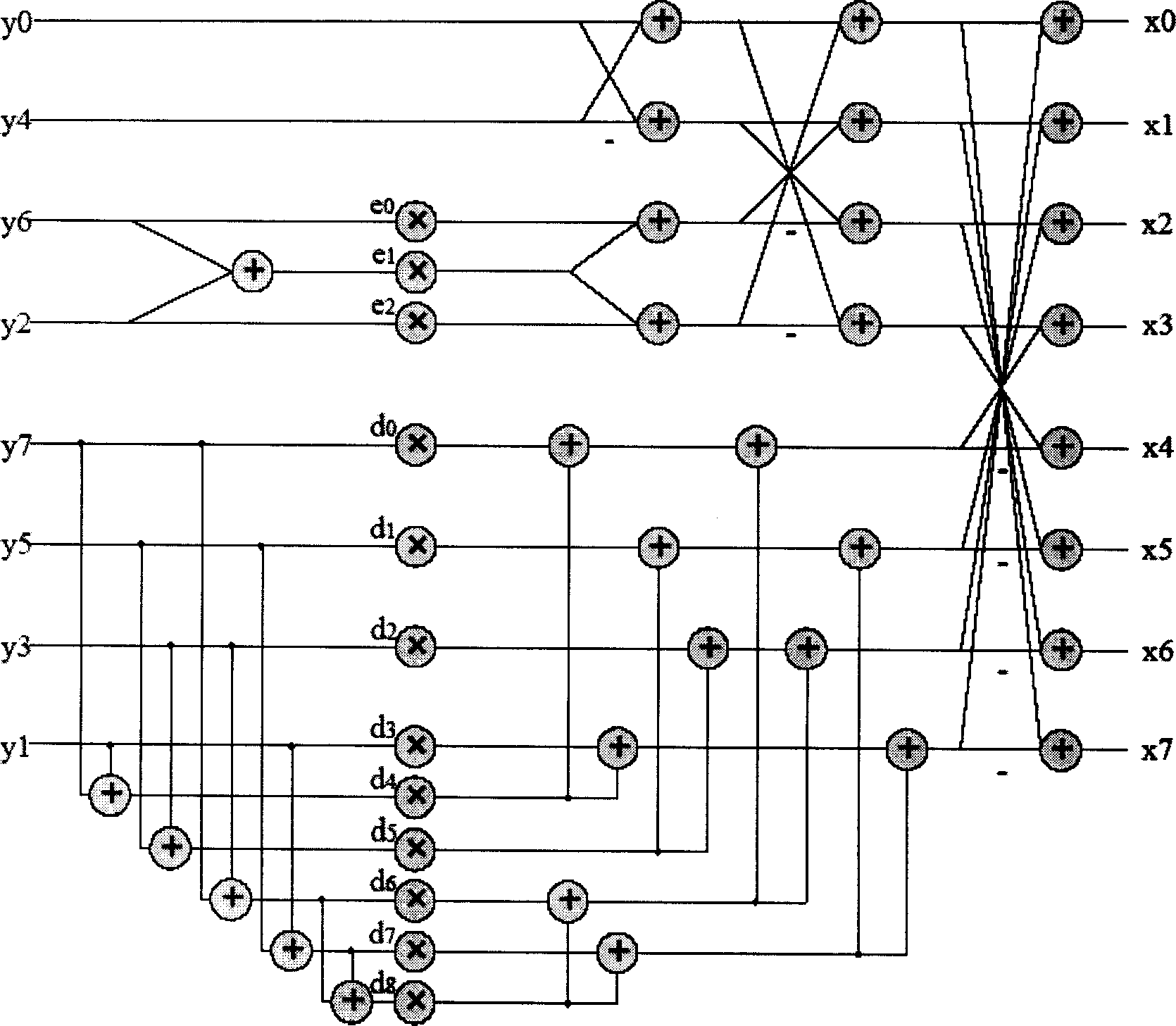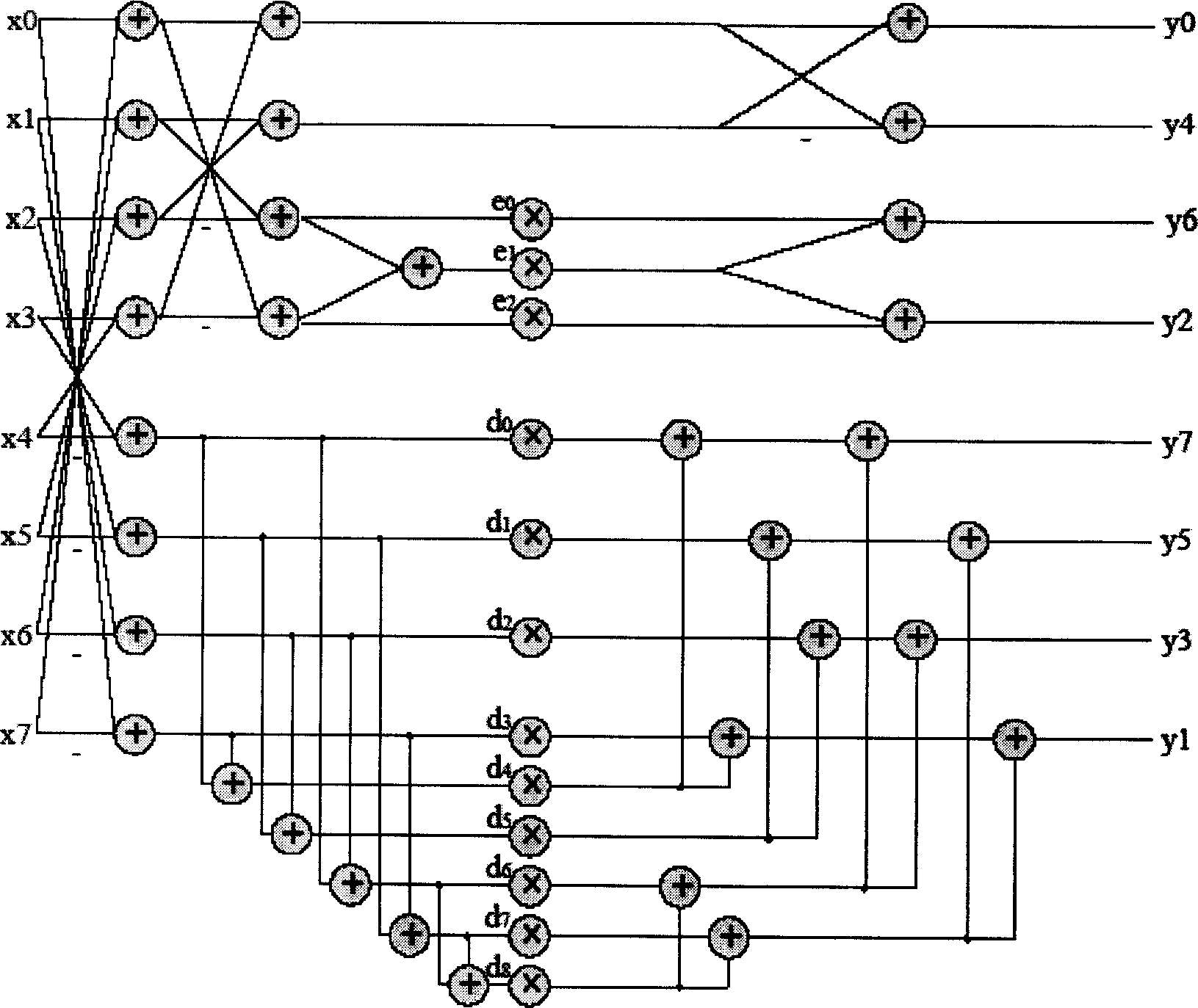Discrete cosine transforming method operated for image coding and video coding
A discrete cosine transform, discrete cosine technology, applied in image communication, digital video signal modification, television and other directions, can solve problems such as low complexity, less addition and shift implementation, etc.
- Summary
- Abstract
- Description
- Claims
- Application Information
AI Technical Summary
Problems solved by technology
Method used
Image
Examples
Embodiment 1
[0052] use image 3 The Inverse Discrete Cosine Transform butterfly structure is shown.
[0053] The inverse discrete cosine transform process is as follows:
[0054] Input the row or column of the 8×8 matrix A into the inverse discrete cosine transform as the input of the butterfly structure of the discrete cosine transform in turn, and output it as the corresponding row or column to obtain the 8×8 intermediate matrix B, and then use the column or row of the matrix B In turn, it is used as the input of the discrete cosine inverse transform butterfly structure, and the output is used as the corresponding column or row to obtain an 8×8 output matrix C.
[0055] image 3 The multiplier parameters in the shown IDCT butterfly structure are as follows: α=cos(3π / 8), β=sin(3π / 8), γ=cos(5π / 16), δ= sin(5π / 16), κ=(cos(π / 16)-cos(5π / 16)), λ=(sin(5π / 16)-sin(π / 16)), μ=(cos (5π / 16)-sin(π / 16)), ν=(cos(π / 16)+sin(5π / 16)), so that the sum of the elements in the matrix C is the two-di...
Embodiment 2
[0057] use Figure 4 The discrete cosine transform butterfly structure is shown.
[0058] The discrete cosine transform process is as follows:
[0059] Input discrete cosine positive transform into the row or column of 8×8 matrix A in turn as the input of discrete cosine positive transform butterfly structure, output as the corresponding row or column to get 8×8 intermediate matrix B, and then the column or row of matrix B In turn, they are used as the input of the discrete cosine positive transform butterfly structure, and the output is used as the corresponding column or row to obtain an 8×8 output matrix C.
[0060] Figure 4 The multiplier parameters in the shown DCT butterfly structure are as follows: α=cos(3π / 8), β=sin(3π / 8), γ=cos(5π / 16), δ= sin(5π / 16), κ=(cos(π / 16)-cos(5π / 16)), λ=(sin(5π / 16)-sin(π / 16)), μ=(cos (5π / 16)-sin(π / 16)), ν=(cos(π / 16)+sin(5π / 16)), so that the sum of the elements in the matrix C is the two-dimensional theoretical discrete cosine sine...
Embodiment 3
[0062] use image 3 The Inverse Discrete Cosine Transform butterfly structure is shown.
[0063] The inverse discrete cosine transform process is as follows:
[0064] Firstly, the input 8×8 matrix A is preprocessed to obtain the 8×8 matrix B. The preprocessing process is as follows: B(i, j)=A(i, j)×S(i, j) 0≤i, j≤7. The matrix S is defined as follows:
[0065] S = a b c d a b c d b d f d b d f ...
PUM
 Login to View More
Login to View More Abstract
Description
Claims
Application Information
 Login to View More
Login to View More - R&D Engineer
- R&D Manager
- IP Professional
- Industry Leading Data Capabilities
- Powerful AI technology
- Patent DNA Extraction
Browse by: Latest US Patents, China's latest patents, Technical Efficacy Thesaurus, Application Domain, Technology Topic, Popular Technical Reports.
© 2024 PatSnap. All rights reserved.Legal|Privacy policy|Modern Slavery Act Transparency Statement|Sitemap|About US| Contact US: help@patsnap.com










